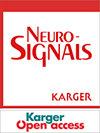锂敏感存储操作Ca2+进入调控FGF23释放
Q1 Medicine
引用次数: 24
摘要
背景/目的:锂是一种广泛用于治疗情绪障碍的药物,先前已被证明可以刺激成纤维细胞生长因子FGF23的释放,FGF23是1,25(OH)2D3形成和矿物质代谢的强大调节剂。所涉及的细胞机制仍然难以捉摸。锂已被证明可以修饰Ca2+信号。在各种各样的细胞中,Ca2+进入是由形成孔的Ca2+通道亚基Orai1及其调节因子STIM完成的,它在细胞内Ca2+储存耗尽后刺激Orai。促进Orai1表达的转录因子包括NF-κB。因此,本研究探讨了锂对FGF23的影响是否涉及并需要Ca2+进入。方法:采用UMR106成骨细胞和永生化原代成骨细胞(IPO)进行实验。通过qRT-PCR估计FGF23和Orai1转录物水平,通过Fura2荧光估计胞质Ca2+浓度([Ca2+]i),通过thapsigarin(1µM)抑制肌内质Ca2+ atp酶(SERCA)抑制储存消耗后[Ca2+]i增加的储存操作Ca2+进入(SOCE)。结果:锂处理可增强UMR106细胞的SOCE, Orai1抑制剂2-APB(50µM)可消除该作用。FGF23转录物水平在锂的作用下升高,而在Orai1抑制剂2-APB(50µM)和YM58483 (100 nM)以及NF-κB抑制剂wogonin(100µM)和withaferin A (500 nM)的作用下受到抑制。此外,锂离子可上调Orai1转录水平,而wogonin和withaferin a可减弱这一作用。结论:锂离子刺激FGF23释放至少部分是通过NF-κB依赖性上调Orai1转录和储存Ca2+进入来实现的。本文章由计算机程序翻译,如有差异,请以英文原文为准。
Lithium- Sensitive Store-Operated Ca2+ Entry in the Regulation of FGF23 Release
Background/Aims: Lithium, a widely used drug for the treatment of mood disorders, has previously been shown to stimulate the release of fibroblast growth factor FGF23, a powerful regulator of 1,25(OH)2D3 formation and mineral metabolism. The cellular mechanisms involved have remained elusive. Lithium has been shown to modify Ca2+ signaling. In a wide variety of cells, Ca2+ entry is accomplished by the pore-forming Ca2+ channel subunit Orai1 and its regulator STIM, which stimulates Orai following Ca2+ depletion of intracellular stores. Transcription factors promoting Orai1 expression include NF-κB. The present study thus explored whether the effect of lithium on FGF23 involves and requires Ca2+ entry. Methods: Experiments were performed in UMR106 osteoblastic cells and immortalized primary osteoblasts (IPO). FGF23 and Orai1 transcript levels were estimated from qRT-PCR, cytosolic Ca2+ concentration ([Ca2+]i) from Fura2 fluorescence and store-operated Ca2+ entry (SOCE) from an increase in [Ca2+]i following store depletion by inhibition of the sarcoendoplasmatic Ca2+ ATPase (SERCA) with thapsigargin (1 µM). Results: SOCE in UMR106 cells was enhanced by lithium treatment, an effect abrogated by Orai1 inhibitor 2-APB (50 µM). FGF23 transcript levels were increased by lithium and inhibited by Orai1 inhibitors 2-APB (50 µM) and YM58483 (100 nM) as well as NF-κB inhibitors wogonin (100 µM) and withaferin A (500 nM). Moreover, Orai1 transcript levels were up-regulated by lithium, an effect attenuated by wogonin and withaferin A. Conclusion: Lithium stimulates FGF23 release at least in part by NF-κB dependent up-regulation of Orai1 transcription and store operated Ca2+ entry.
求助全文
通过发布文献求助,成功后即可免费获取论文全文。
去求助
来源期刊

Neurosignals
医学-神经科学
CiteScore
3.40
自引率
0.00%
发文量
3
审稿时长
>12 weeks
期刊介绍:
Neurosignals is an international journal dedicated to publishing original articles and reviews in the field of neuronal communication. Novel findings related to signaling molecules, channels and transporters, pathways and networks that are associated with development and function of the nervous system are welcome. The scope of the journal includes genetics, molecular biology, bioinformatics, (patho)physiology, (patho)biochemistry, pharmacology & toxicology, imaging and clinical neurology & psychiatry. Reported observations should significantly advance our understanding of neuronal signaling in health & disease and be presented in a format applicable to an interdisciplinary readership.
 求助内容:
求助内容: 应助结果提醒方式:
应助结果提醒方式:


